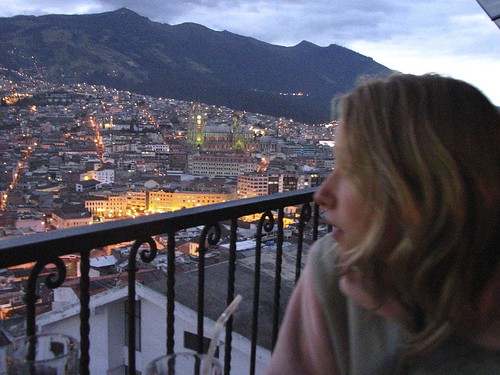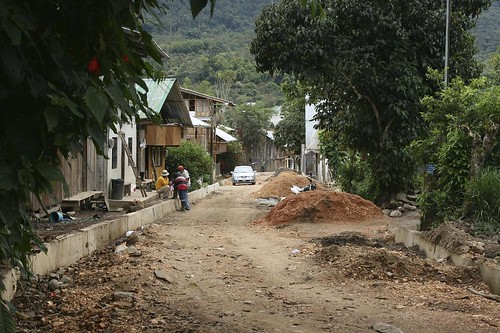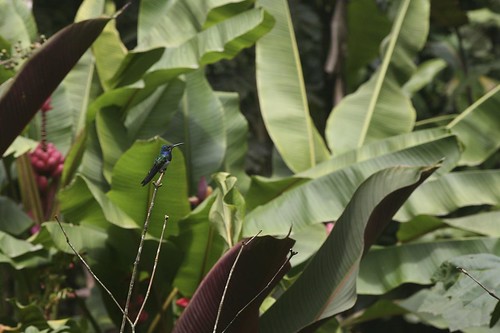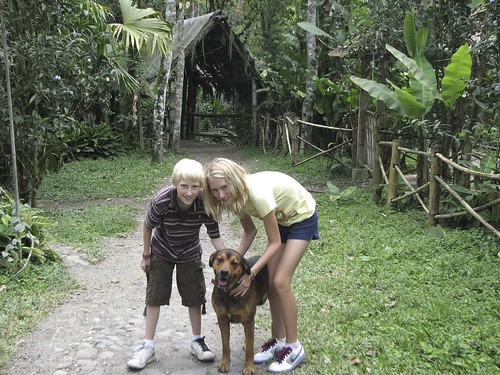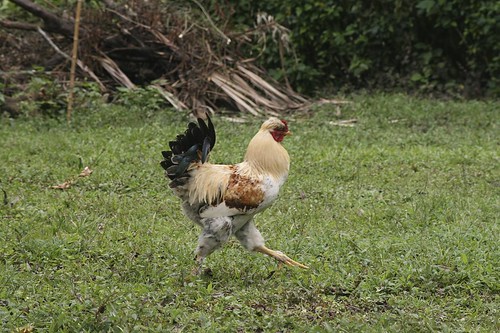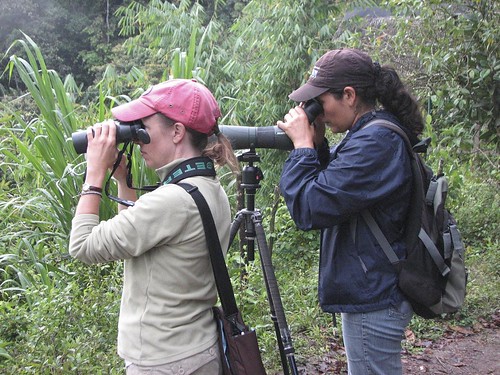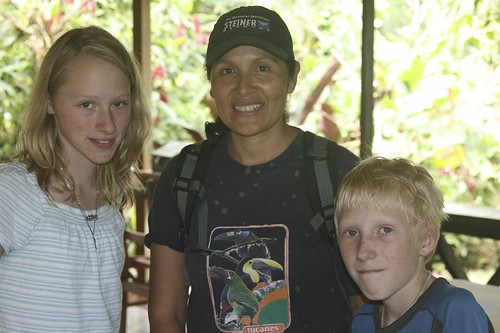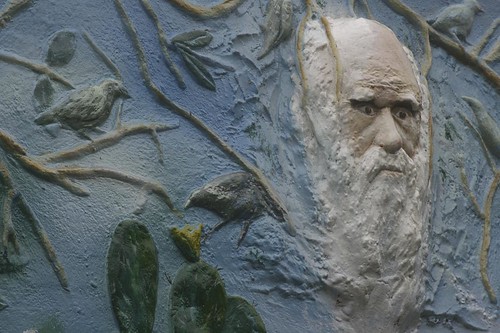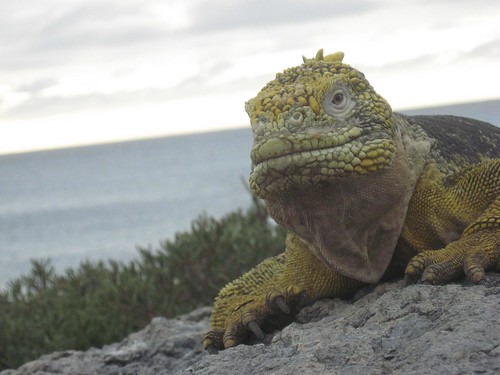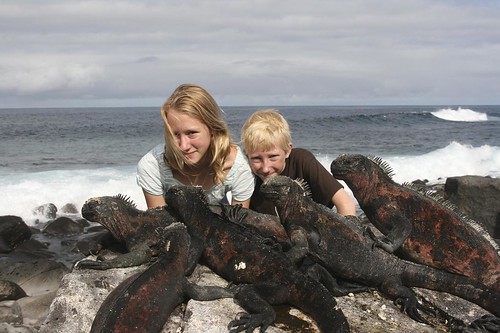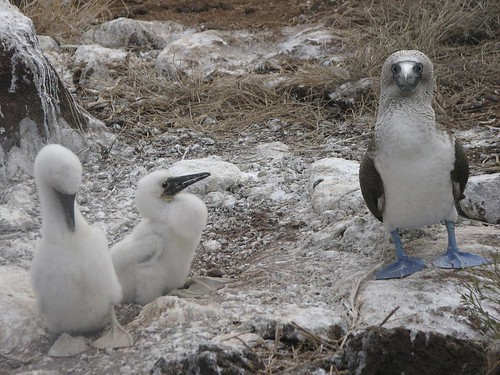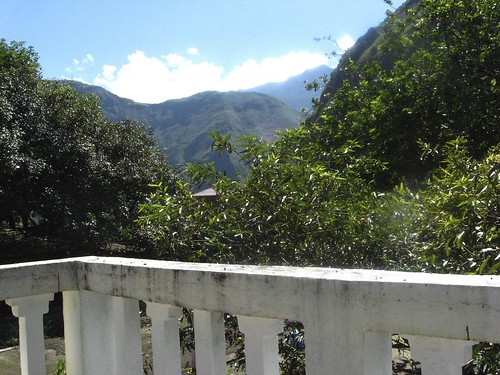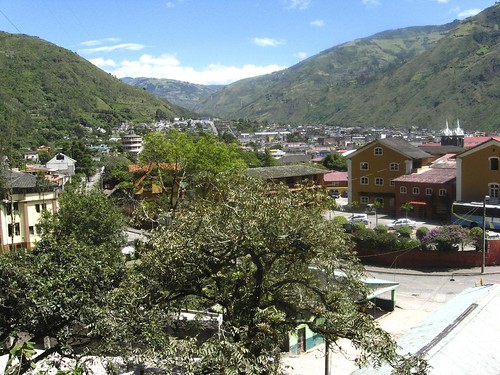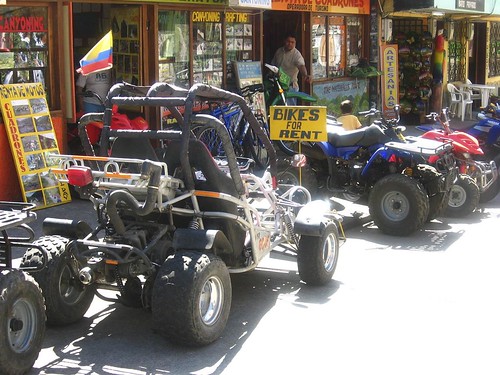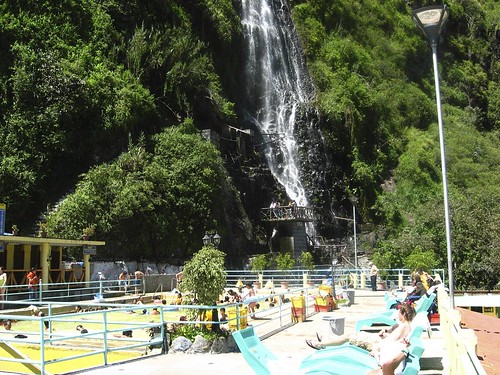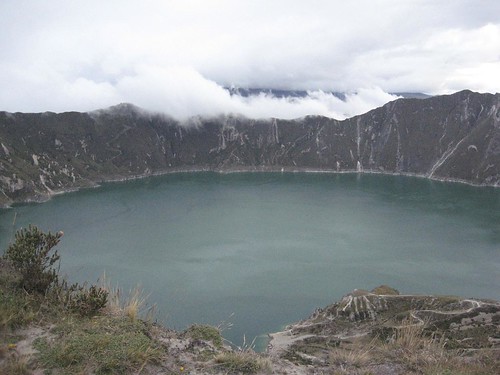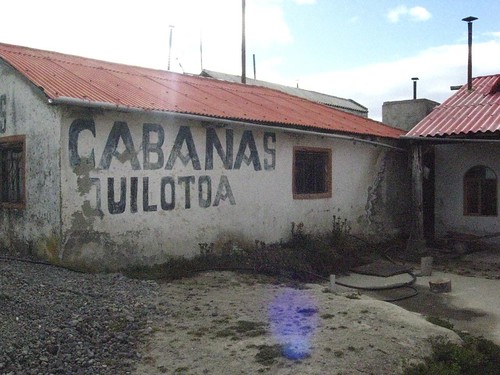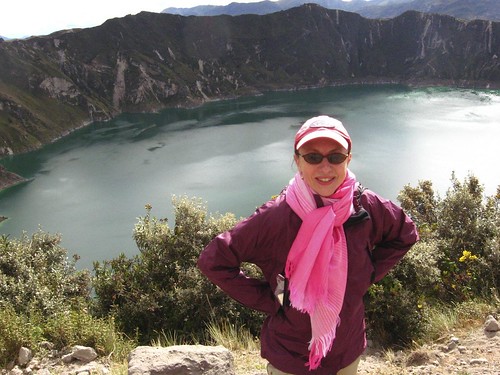Posts from — August 2008
Our Time in Ecuador
On our final night in Ecuador we had dinner at Cafe Mosaico, considered by the New York Times to be the “most spectacular eatery in Ecuador.” It’s an amazing place to watch the sun set and the city lights come on.
Our final report on our time in Ecuador – what we did, what we recommend – is here.
August 28, 2008 2 Comments
More Than Meets The Eye
For a different view of Ecuador, we headed to Mindo, in the Cloud Forest, for a few days. But when we arrived, instead of clouds, the roads were what caught our attention. And we wondered if we’d made a mistake in coming.
But were were there. So we settled in to El Descanso (clean and with a lovely hummingbird garden behind the dining room).
We took a long walk up the tropical path to the Butterfly Garden accompanied by “Friendly” the dog. He became our spirit guide for the afternoon; he walked us everywhere until we got back to town. He made us realize that it’s not the condition of the road, but who you’re walking with that matters.
Inside the butterflies’ enclosure, I was most excited to see the irridescent blue morpho; Caroline had done a project on this very butterfly in Sra. Newman’s class in third grade. The morpho was shy, but this Ojo de Buho (“owl eyes”) butterfly found a nice spot to pose for our camera.
Early the next morning (after a 5:30 breakfast!), we joined Julia Patino, a birdwatching guide, for a trek into the misty hills to see toucans, tanagers, cuckoos, and parrots. This less rare beauty served as our alarm clock:
We spent the afternoon on the river in tied-together inner tubes while guides muscled the make-shift craft around boulders and through coursing rapids. (We left the camera at the hostel for fear of losing it in the water.)
As we prepared to head back to Quito, we stopped in for a delicious fruit shake at our favorite place in town – this juice bar run by a young ex-pat from Germany.
Mindo had grown on us, and once again we were reminded that first impressions are often wrong.
There are more pictures of Mindo posted here.
August 26, 2008 4 Comments
Tour of the GAP II
Conor takes us on a tour of the GAP Adventurer II (a.k.a. Cruz del Sur) in a way that only he can…
August 22, 2008 13 Comments
Father & Son
I recently read the story of a young man who was both a worry and a disappointment to his parents.
The father wanted his son to be a doctor, but the young man flunked out of medical school. The boy was considered by all to be rather average, and he had few prospects.
With medical school out of the question, the father pushed his son to become a clergyman, and the young man had resigned himself to the idea.
But then came the opportunity for the son to take a trip around the world.
The young man was very interested, but needed his father’s permission and financial support. His father objected to such a frivolous waste of his son’s time.
Fortunately, a kindly uncle intervened.
He convinced the boy’s father that his son had a unique opportunity to do something few would ever have the chance to do. And along the way, his son might just find his way in the world.
The father relented and allowed his son to travel around the world.
The boy, of course, was Charles Darwin. And the trip he took round the world – five years in all – was described in the book Voyage of the Beagle.
The rest, as they say, is history.
Darwin’s father didn’t live long enough to see the impact his “aimless” son had on our understanding of the natural world.
But one tribute to Darwin’s life work lives on at the Charles Darwin Research Center on Santa Cruz Island in the Galapagos.
The center has become an important advocate and advisor for protecting the Galapagos. One of their most important missions has been to help repopulate the islands with giant tortoises, which where well on their way to becoming extinct.
August 22, 2008 Comments Off on Father & Son
Galapagos Day
[Special thanks for Brantley Tillis for the use of his terrific underwater footage.]
August 20, 2008 5 Comments
Where Animals Rule
On the public pier in Puerto Baquerizo Moreno, San Cristobal Island, we encountered a slight bump in the road.
At least a half dozen sea lions were blocking our way, lounging on the steps we needed to descend to board the dinghy that would take us to the Cruz del Sur, our home for the next week.
When it became apparent the sea lions weren’t quite ready to give up their resting spot, Hanzel, our naturalist guide, led us to another dock where we were able to board our dinghy.
To travel to the Galapagos is to travel to a alternate universe where sea lions, marine iguanas, giant tortoises and blue-footed boobies rule, and where they have found a way to live in harmony.
After centuries on islands with no natural predators, Galapagos wildlife is ridiculously tame.
Seventeenth and eighteenth century sailors were amused by the animals’ “stupidity.” They never had to hunt for food on the Galapagos; they simply went ashore and grabbed what they wanted, as if visiting a precursor to the modern supermarket.
The animals never fought back or fled. They knew no danger.
Today their main annoyance is hundreds of pesky humans constantly pointing a camera their way. Paparazzi in Patagonia clothing.
Our friends, the Gugel-McPhersons (Gail, David, Cam & Meg) joined us on a nearly flawless GAP Adventures family cruise to these other-worldly islands.
August 18, 2008 7 Comments
Chillin’ in Banos
Banos is the kind of place a person could go to disappear for a while. That’s what American expats Marshia Jackson and Jim Redd appear to have done.
The pair left Chicago in 2004 and bought the Banos B&B Posada del Arte, where we had the pleasure to stay during our visit to this picturesque adventure-filled town.
Jackson and Redd have created a lovely, comfortable B&B which they have filled with imaginative Ecuadorian art. They recently took over management of Casa del Abuelo, just around the corner. It too is being filled with local paintings, sculptures and other works of art.
Banos was the third stop on our Ecuadorian road trip. Every Quiteno we spoke to strongly recommended visiting the place; we’re glad we did.
The small, compact town, surrounded by mountains, is one of Ecuador’s most popular destinations. It is also the gateway to the jungle – Ecuador’s Amazon Basin.
There are dozens of tour operators offering mountain biking, rafting, canyoning and jungle adventures.
While there is plenty of adventure to be found in Banos, we were in town to relax, so we took in the attraction from which the town takes its name: the steaming thermal baths (banos) heated by the volcano Tungurahua.
After a great dinner and a relaxing night’s sleep at Casa del Abuelo, we went to town’s best known bath, La Piscina de La Virgen.
The baths have three pools of varying temperatures – one cold, another warm and one that reaches nearly 115 degrees – making it a popular spot for vacationing Ecuadorian families.
The murky water (containing chlorates, sulfates and magnesium) is known for its “restorative and healthful properties.”
While there, we mimicked the locals who stood under a cold shower of water diverted from a nearby waterfall, then jumped into the hot pool.
It was the perfect antidote to our bone-chilling night at Laguna Quilotoa.
In fact, the only reason to leave Banos would be another eruption of Tungurahua, the active volcano that looks over the town.
So long as Tungurahua only belches smoke and ash, it’s just another tourist attraction in a town that offers the right mix of adventure and relaxation.
August 14, 2008 4 Comments
Ecuador Road Trip
August 12, 2008 9 Comments
Into The Volcano
We left the main road at Latacunga, and each successive town we passed seemed smaller, poorer and more primitive.
We were headed to Laguna Quilotoa, a volcanic crater lake that is indisputably one of Ecuador’s most breathtaking sights.
Our guide Patricio drove cautiously along winding switchback turns as we made the ascent to 12,800 feet. It took us nearly two hours to drive 50 miles on poorly paved roads.
We reached the village of Quilotoa at dusk. A tiny village has taken root on the southwest side of the volcanic crater to cater to tourists. It’s about the only place in Ecuador where the accommodations are actually run by local indigenous people.
Several Quichua families run very rustic hostels – most have no heat and no hot water. What visitors sacrifice in comfort, they gain in the opportunity to spend time with indigenous families.
But the prime attraction is the crater lake itself, and it is truly an awe-inspiring sight. We hiked down 800m from the crater rim to the aqua-green alkaline lake below.
But instead of climbing out, we took the easy way back to the rim. Young Quichua children lead caravans of burros up the steep, narrow paths. The ride up is harrowing at times – but it sure beats walking.
And considering the altitude, it’s the best five dollars (per person) you could ever spend.
August 7, 2008 6 Comments
Observed in Laguna Quilotoa
In a remote town high in the Ecuadorean Andes, a small group of indigenas men gathered around a 19-inch color TV watching a crystal clear DVD copy of the new Batman movie, The Dark Knight, less than two weeks after it was released in the United States.
August 7, 2008 3 Comments

